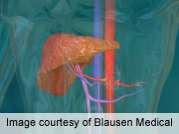(HealthDay)—The Alcohol Use Disorders Identification Test for alcohol consumption (AUDIT-c) combined with urinary ethyl glucuronide (uEtG) testing improves the detection of alcohol consumption in liver transplant candidates and recipients, according to a study published online April 2 in Liver Transplantation.
Salvatore Piano, M.D., from the University of Padova in Italy, and colleagues evaluated uEtG, AUDIT-c, serum ethanol, urinary ethanol, carbohydrate-deficient transferrin (CDT), and other indirect markers of alcohol consumption in 121 liver transplant candidates (LTCs) and liver transplant recipients (LTRs).
The researchers found alcohol consumption in 30.6 percent of patients. The strongest marker of alcohol consumption was uEtG (odds ratio, 414.5; P < 0.0001), which showed a more accurate prediction rate of alcohol consumption compared to CDT (area under the receiver operating characteristic curve [AUROC], 0.94 versus 0.63; P < 0.0001) and AUDIT-c (AUROC, 0.94 versus 0.73; P < 0.0001). An even higher accuracy in detecting alcohol consumption was seen with the combination of uEtG with AUDIT-c, compared to the combination of CDT and AUDIT-c (AUROC, 0.98 versus 0.80; P < 0.001). In patients with a negative AUDIT-c, uEtG was the most useful marker for detecting alcohol consumption.
"In conclusion, the association of AUDIT-c and uEtG improves the detection of alcohol consumption in LTCs and LTRs," the authors write.
More information:
Abstract
Full Text (subscription or payment may be required)
Journal information: Liver Transplantation
Copyright © 2014 HealthDay. All rights reserved.




















